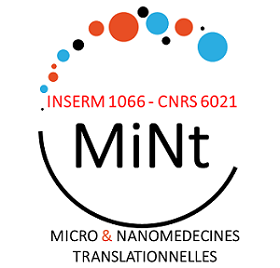Self-assemblies of azacitidine prodrugs : a promising strategy of treatment for myelodysplastic syndromes and acute myeloid leukemia
Auto-assemblages de prodrogues de l’azacitidine : une stratégie d’intérêt pour le traitement des syndromes myélodysplasiques et des leucémies aiguës.
Résumé
5-Azacitidine, a cytidine analogue and a hypomethylating agent, is one of the main drugs being used for the treatment of myelodysplastic syndromes and of acute myeloid leukemia. However, after administration, it exhibits several limitations including restricted cancer cell internalization due to its hydrophilicity, and a rapid enzymatic degradation by adenosine deaminase. The aim of this project was to improve the cancer cell internalization and protect it from metabolic degradation via the synthesis of an amphiphilic prodrug and their potential self-assembly. The azacitidine was conjugated to two different omega-3 fatty acids, the eicosapentaenoic acid (EPA) and the docosahexaenoic acid (DHA). The carboxylic acid group of the omega-3 fatty acids was covalently conjugated to the amine group of azacitidine, yielding an amphiphilic prodrug. Next, the nanoprecipitation of the obtained prodrugs was performed and self-assemblies were successfully obtained for both prodrugs with a diameter of around 200 nm, a polydispersity index below 0.2 and a positive zeta potential. Both self-assemblies had an IC50 close toazacitidine on a human leukemia cell line HL-60. Moreover, AzaEPA self-assemblies showed a slow and gradual cell internalization. This strategy would allow protection while increasing azacitidine specificity and bioavailability.
La 5-Azacitidine, analogue de lacytidine et agent hypométhylant, est l'une des molécules principales utilisées pour le traitement des syndromes myélodysplasiques et des leucémies aiguës. Cependant, après administration, cette molécule présente une faible efficacité thérapeutique : internalisation cellulaire limitée à cause de son caractère hydrophile et dégradation enzymatique rapide par l’adénosine déaminase. L'objectif de ce projet est ainsi d'améliorer l’activité de la molécule et de la protéger de la dégradation enzymatique via le développement d'une prodrogue amphiphile capable potentiellement de s’auto-assembler. L'azacitidine a été donc été conjuguée à deux acides gras différents, dérivés de l'oméga 3 : l’acide eicosapentaénoïque (EPA) et l’acide docosahexaénoïque (DHA). Le groupement acide carboxylique de l'acide gras a été couplé covalemment au groupement amine de l'azacitidine, donnant ainsi une prodrogue amphiphile. Ensuite, la nanoprécipitation des prodrogues a été réalisée et des auto-assemblages ont été obtenus pour les deux molécules avec un diamètre de l’ordre de 200nm, un indice de polydispersité inférieur à 0.2 et un potentiel zêta positif. Les deux types d’auto-assemblages avaient une IC50 proche de l'azacitidine sur la lignée cellulaire HL-60, une lignée cellulaire de leucémie humaine. Les auto-assemblages d’AzaEPA ont également montré une internalisation cellulaire lente et progressive dans cette même lignée. Ainsi, cette stratégie permettra la protection de l'azacitidine tout en améliorant sa spécificité et sa biodisponibilité.
Origine : Version validée par le jury (STAR)
